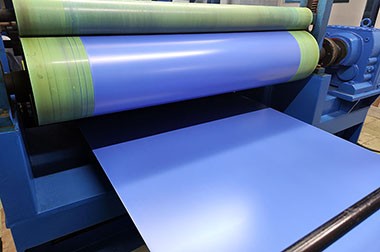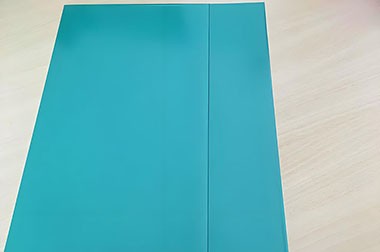Mar. 28, 2025
The main difference between Thermal CTP and Violet CTP lies in how they image the plates, as well as the trade-offs in terms of quality, speed, and cost.
Both Thermal and Violet CTP (Computer-to-Plate) technologies are widely used in offset printing, with each technology having its own advantages and limitations.
| Comparison Item | Thermal CTP | Violet CTP |
| Product Image |
 |
 |
| Imaging Principle | Uses thermal lasers to directly heat the photosensitive layer to form the image | Uses violet laser (405nm) to form the image through a photochemical reaction |
| Resolution and Accuracy | High resolution (0.5%–99.5% dots) | High resolution (2%–98% dots), but slightly lower than Thermal CTP |
| Imaging Speed | Slower imaging speed, suitable for fine printing | Faster imaging speed, suitable for high-volume production |
| Plate Types | Uses thermal plates, typically requiring no development or chemical processing | Uses violet-sensitive plates, some requiring chemical development |
| Environmental Friendliness | Tends towards chemical-free processing, reducing pollution | Some violet-sensitive plates still require chemical processing, though there are chemical-free options |
| Cost | Higher equipment and plate costs | Lower initial investment and plate costs |
| Maintenance Requirements | Low maintenance, stable optical system | Requires regular cleaning and maintenance, especially when using silver-based plates |
| Application Areas | High-end packaging, fine art printing, commercial promotional materials, etc. | Newspaper printing, commercial printing, high-volume publications, etc. |
| Image Stability | High image stability, excellent long-term preservation | Good image stability, but not as durable as thermal plates |
| Chemical Usage | More environmentally friendly chemical-free plate options | Some plates still require developer treatment |
| Return on Investment | Suitable for applications requiring extremely high quality, with higher efficiency in the long term | Suitable for high output, fast-paced production environments, with a shorter ROI cycle |
| Category | Thermal CTP | Violet CTP |
| Light Source | Uses 830nm infrared laser, imaging through thermal effects (such as ablation, cross-linking, or decomposition). | Uses 405nm blue-violet semiconductor laser, in the visible light range, for imaging through a photochemical reaction. |
| Imaging Mechanism | Laser energy is converted into heat, altering the surface material of the plate (such as dissolving or curing the coating). For example, thermal ablation plates vaporize the coating to form image areas, while thermal cross-linking plates use heat to initiate chemical reactions to cure the coating. | The photosensitive material absorbs violet laser energy and undergoes polymerization or decomposition reactions, creating differences between image and non-image areas. |
Thermal CTP:
Generally highly sensitive to heat, offering excellent dot reproduction (usually covering a dot range of 0.5%–99.5%). However, its imaging process may be slightly slower compared to violet systems.
Violet CTP:
Provides faster imaging speed, suitable for high-volume production (such as commercial or newspaper printing). Its dot reproduction is typically narrower (around 2%–98%), which is adequate for many applications.
Initial Investment: Violet systems are cheaper due to simpler optical components and a single laser diode. Thermal equipment involves a complex multi-diode system, which increases upfront costs.
Operating Costs:
Violet: Higher chemical usage (e.g., developers, glues) and higher processor maintenance costs. Silver-based plates also incur environmental disposal costs.
Thermal: Lower chemical costs, especially for process-free plates. However, laser replacements (e.g., multiple diode heads) and plate holders can be expensive.
| Item | Thermal CTP | Violet CTP |
| Plate | Typically uses more complex non-silver formulations, focusing on high-quality output. | Typically simpler and more cost-effective. |
| Maintenance | The equipment may involve more expensive optical components and requires careful control of process conditions, but the overall chemical usage is lower. | May require more frequent maintenance or cleaning (especially with silver-based chemicals), although modern systems increasingly offer chemical-free options. |
| Cost | Higher initial investment but ideal for applications where image quality is critical (e.g., luxury packaging). | Lower upfront cost, making it attractive for medium-to-high volume, cost-sensitive environments. |
Thermal CTP:
Ideal for high-quality, critical jobs where fine details and consistent high-resolution output are essential. It may require dedicated equipment and process adjustments, making it the preferred choice for high-end packaging and artistic printing.
Violet CTP:
Generally more compatible with existing equipment and workflows, allowing for easier integration. Its faster imaging speed makes it ideal for commercial printing applications where turnaround time is crucial.
| Type | Application Scenarios | Print Adaptability |
| Thermal CTP | Suitable for long-run printing, with high resistance to printing wear, especially when baked plates are used. | Supports FM screening and high-precision dots (minimum dot size 10μm); requires stable printing environment, with control over exposure temperature and development conditions. |
| Violet CTP | Suitable for medium-to-short run printing and newspapers, with fast plate-making speed. | Some plates can directly use traditional PS plate bases, offering good compatibility; sensitive to dust, requiring a clean environment; high repeatability (±2μm), but large-area screens may have seam issues due to stepping errors. |
Users viewing this material also viewed the following
Further reading: thermal ctpctp thermalctp thermal platepositive thermal ctp platethermal ctp machinethermal ctp platethermal ctp systemsviolet ctp platesviolet ctp machine